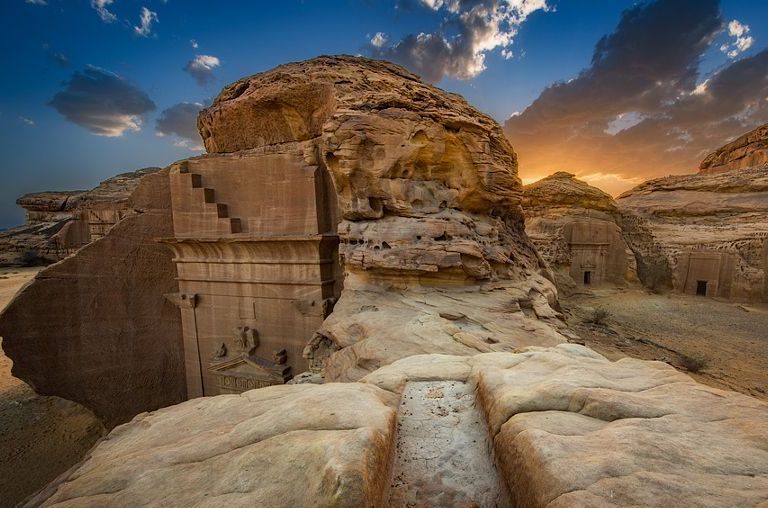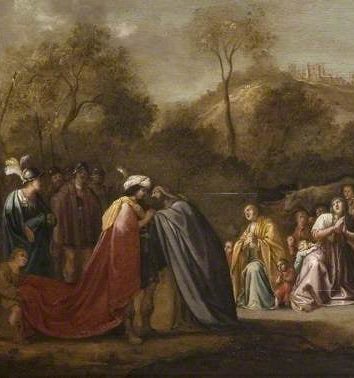
“In the Qur’an … there are verses that refer to the people’s concern for their noble descent and genealogies, but not their view in relation to this. Nor can one get the feeling anywhere in the Qur’ān of the existence of the idea – which the narrators later insisted on – of the division of the Arabs into two or three classes, or the existence of two or more lineages for the Arabs. It does not mention the name ‘Adnān or Qaḥṭān, nor any of those things that the narrators and story-tellers cling to, telling us that these were some of the established facts in the genealogy of the Arabs, and that the Arabs were truly descended from one of two grandfathers: ‘Adnān and Qaḥṭān.” [1]
ACCORDINGLY, WE CAN say that all works of Arab genealogy are nothing but tales written by some who claimed to know the genealogies of the Arab tribes. In sharp contrast to the Qur’ān, however, we find that the Old Testament in the Bible is deeply concerned with lineage and lists all the Hebrew tribes and their genealogies. It also mentioned some Arab tribes.
Now what concerns us here is the lineage of Ismāʽīl ibn Ibrāhīm al-Khalīl. Abraham gave birth to Ishmael, then Isaac. And since Ishmael was descended from the Egyptian maidservant Hagar, while Isaac was descended from Abraham’s wife Sarah, the precedence was given to Isaac. Abraham therefore expelled his Egyptian maidservant along with her son Ismāʽīl, to settle somewhere in the Sinai desert near Beersheba. When Ismāʽīl grew up his mother brought him an Egyptian wife, as the Hebrew sources say. Ismāʽīl then sired twelve sons who formed the tribes known as the Ishmaelites, and who lived north of the Nafud Desert.
As for Isaac, he engendered Esau and Jacob (Israel). Esau was not bound by the Hebrew laws and married into the tribes of Canaan whom the Hebrews were persecuting. Isaac therefore promised his favorite son, Jacob, the land that God had promised them (Palestine), while Esau settled to the southeast of this region, near the Nefud Desert. All the descendants of Ismāʽīl lived in the region of Jordan and northern Arabia.
The Ismāʽīlīs, or ‘Hagarites’ after the Egyptian maidservant Hagar, stand as the origin of the various Arab tribes. But there is one of the five sons of Esau, named Eliphaz, who gave birth to six children. The tribe of ‘Ād, known in the Old Testament as ‘Uz’ or ‘Ud’, is descended from one of them called Gatam. Perhaps this became Qaḥṭān in the Arabic translations, and they went on to attribute to him the Qaḥṭān Arabs, that is, the Bedouin Arabs.
The area in which Esau settled was called Seir (Genesis 36, verses 6-7). This area lies in present-day Jordan between the Gulf of Aqaba and the Dead Sea.[2] Some of the inhabitants of this region migrated to the south of the Arabian Peninsula and formed the Kingdom of Sheba in Yemen around 1200 BC, as well as the rest of the tribes in and around Hadramaut. One of Abraham’s sons was named Midian, and he settled along with his descendants in the area southeast of the Gulf of Aqaba to form the tribe of Midian, to whom Moses fled from Egypt after killing the Egyptian, as the Old Testament says. The city of Al-Ḥijr (Madā’in Saliḥ) and the surrounding area were inhabited by the Nabataean tribes (Thamūd), who gradually migrated to Petra and the surrounding area. However, after their defeat by the Roman forces in 106 AD, the Nabataeans were dispersed and part of them settled in the area inhabited by ‘Ād.[3]
Since most of the Arab tribes were descended from Ishmael and his sons, they must have been professing the monotheism initiated by Abraham. However, because the God of monotheism is far from reach and cannot be seen, many tribes worshiped idols, perhaps as a mediator between them and the distant God that the eye does not see and whose substance man cannot touch.
The division of the Arabs into classes – in terms of antiquity and progress in Arabic – is a division which we find no mention of either in the Torah or any other Jewish resources, or in any Greek, Latin, or Syriac sources. It appears to be a purely Arab division, one which arose from the merging of the Arabs mentioned to have perished before Islam – so that only memories remained of them – with the rest of the Arabs who are either from ‘Adnān or from Qaḥṭān. All of those extinct Arabs, as far as most of the narrators were aware, were: ‘Ād, Thamād, Ṭamīm, Jadīs, Umaym, Jāsim, ‘Abīl, ‘Abd Ḍakham, the ‘First Jurhum’, the ‘Amāliqa and Ḥaḍūra. These are the raw material for the extinct Arabs, the oldest of all the Arab classes in the eyes of the narrators.[4]
Since most of the Arab tribes were descended from Ishmael and his sons, they must have been professing the monotheism initiated by Abraham
These believed that ‘Ād was a descendant of ‘‘Ād ibn ‘Awṣ ibn Iram’. As for Thamūd, these were held to be the descendants of ‘Thamūd ibn Ghāthir ibn Iram’; Ṭasm were held to be from ‘Tasm ibn Lawdh’; Jadīs from ‘Jadīs ibn Ghāthir ibn Iram’ according to one narration or, according from another narration, from ‘Jadīs ibn Lawdh ibn Sām’; Umaym from ‘Umaym ibn Lawdh ibn Sām’; Jāsim from the descendants of ‘Jāsim’ one of the Amalekites the sons of ‘Amlīq and thus the descendants of ‘Lawdh ibn Sām’. And as for ‘Abīl, they the descendants of ‘Abīl ibn ‘Awṣ ibn Iram’ while ‘Abd Ḍakham are among the descendants of ‘Abd Ḍakham scions of Lawdh, themselves issue of the loins of the ‘sons of Iram’ in another narration. As for the ‘First’ Jurhum, these descend from ‘Ābir’ and are different from the ‘Second’ Jurham who are from the Qaḥṭānites. The Amalekites are the sons of ‘‘Amlīq ibn Lawdh’ and as for Ḥaḍūra, these were from al-Rass and perished.[5]
Most of the narrators identified Al-Ḥijr (Madā’in Saliḥ) as the home of Thamūd, and a village in the Wādī al-Qurā. It was visited by a number of geographers and tourists, and these mentioned that it had a well called ‘the well of Thamūd’, and that the Messenger came to it with his Companions at the time of the battle of Tabūk. Al-Masʽūdi mentioned that their homes were between the Levant and the Hijaz towards the coast of the Abyssinian Sea, that their homes were in Fajj al-Nāqa and carved into the mountains, and that their ruins could be seen to his day on the route of those pilgrims who approached the Levant near Wādī al-Qurā.[6]
The Arab tribes, like most of the peoples of the world, passed through several stages on their religious journey from worshiping their ancestors in the form of a ‘totem’, to worshiping the sun, moon and the planets, subsequently embodying the gods in the form of images and idols, before reaching the stage of monotheism.

Suggested Reading
It is said that ‘Amr ibn Luḥayy journeyed the Levant where there was a group of Amalekites who worshipped idols, and he said to them: “What are these idols that I see you worshipping?” They replied, “These are idols that we worship, we seek their help and we are duly helped we seek rain from them and we are given water.” To which he said, “Will you not give me one of these idols so that I may take it to the Arab land to that House of God to which the Arabs flock?” So they gave him an idol called Hubal, and he brought it to Makka and placed it at the Kaʽba, the first idol to be placed in Makka.[7] Works in the traditional contain many names of idols that were worshiped by the Arab tribes as a means to gain God’s favour, such as Hubal, Baal, Wad, Nasr, Sawāʽ, Al-Lāt, and Al-ʽUzza (Venus to the Romans, Aphrodite to the Greeks), and many other names.
Since natural phenomena fascinated them and were difficult for them to understand, they worshiped the moon, which the Arabs of Yemen called Sīn, worshiped the sun as his wife, and the planets as his children. The Nabateans in particular worshiped the sun and in their capital Silaʽ (Petra) had a great temple to honour it, albeit they called it by another name: Dhū Sharā. They venerated the white and black stones in Yemen, the Hijaz, and the land of Nabaṭ. We also find a Temple of the Sun in Ḥomṣ that contained a black stone representing the sun god.[8]
[1] Jawād ‘Alī, المفصل في تاريخ العرب قبل الإسلام , Vol. 1, p.161.
[2] Dan Gibson, Quranic Geography, p 23
[3] Dan Gibson, Op. Cit., p. 50.
[4] Op. Cit., p.132
[5] According to the Qur’an, the People of Al-Rass refused to worship God and were afflicted by His punishment. In a number of hadiths the Al-Rass killed the prophet Hanzala b. Safwan who had tried to stop them practisiing Lesbian sex, but they threw him down a well, for which God sent over the me the Aram flood. (Ed.)
[6] Jawād ‘Alī, المفصل في تاريخ العرب قبل الإسلام , Vol. 1, p.104.
[7] Jawād ‘Alī, Op. cit., p.112.
[8] Fr. Louis Cheikho, النصرانية وآدابها بين عرب الجاهلية، طبعة 2nd. ed. 1989, Dār al-Mashreq Beirut, VOl. 1, pp.5-6.
Main image: Mada’in Salih in northern Saudi Arabia.

